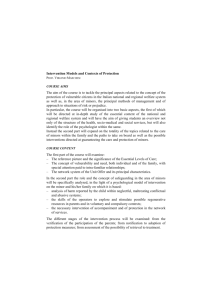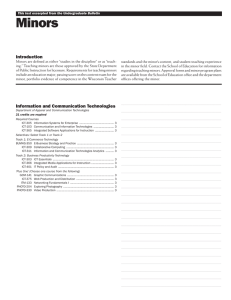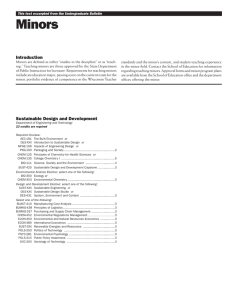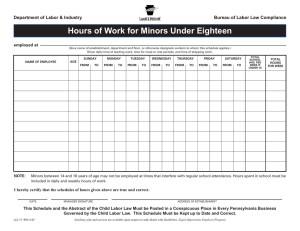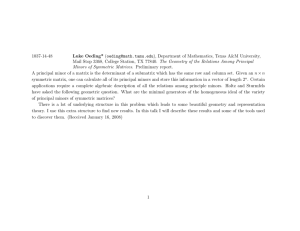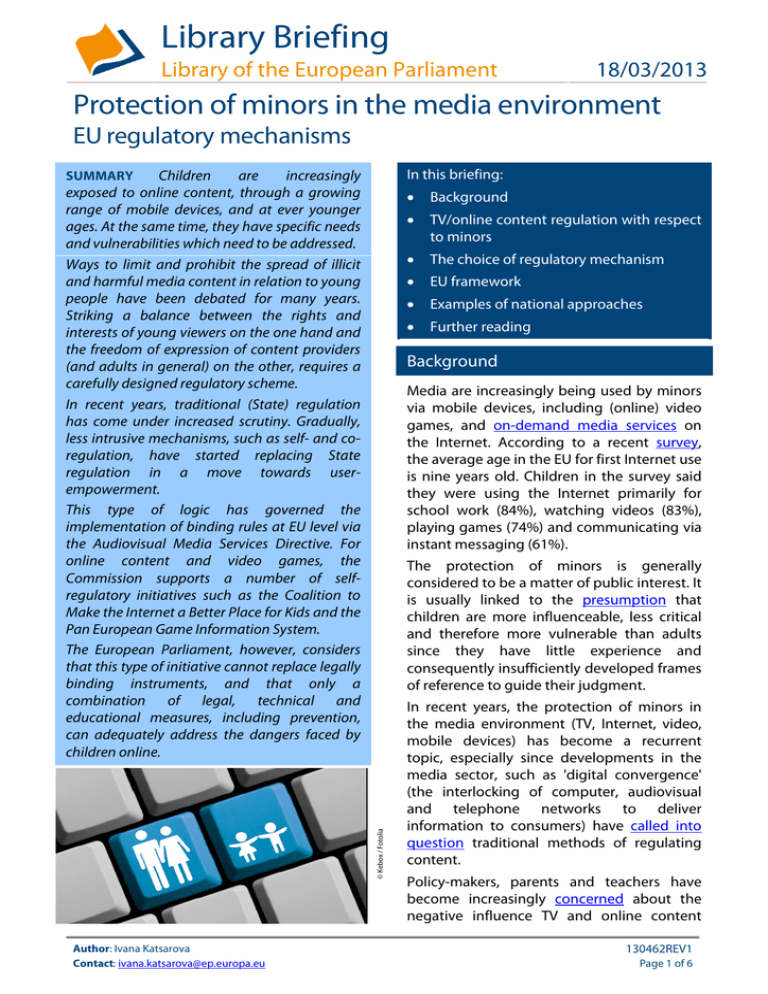
Library Briefing
Library of the European Parliament
18/03/2013
Protection of minors in the media environment
EU regulatory mechanisms
In this briefing:
Children
are
increasingly
exposed to online content, through a growing
range of mobile devices, and at ever younger
ages. At the same time, they have specific needs
and vulnerabilities which need to be addressed.
Ways to limit and prohibit the spread of illicit
and harmful media content in relation to young
people have been debated for many years.
Striking a balance between the rights and
interests of young viewers on the one hand and
the freedom of expression of content providers
(and adults in general) on the other, requires a
carefully designed regulatory scheme.
In recent years, traditional (State) regulation
has come under increased scrutiny. Gradually,
less intrusive mechanisms, such as self- and coregulation, have started replacing State
regulation in a move towards userempowerment.
This type of logic has governed the
implementation of binding rules at EU level via
the Audiovisual Media Services Directive. For
online content and video games, the
Commission supports a number of selfregulatory initiatives such as the Coalition to
Make the Internet a Better Place for Kids and the
Pan European Game Information System.
The European Parliament, however, considers
that this type of initiative cannot replace legally
binding instruments, and that only a
combination of legal, technical and
educational measures, including prevention,
can adequately address the dangers faced by
children online.
SUMMARY
Background
TV/online content regulation with respect
to minors
The choice of regulatory mechanism
EU framework
Examples of national approaches
Further reading
Background
Media are increasingly being used by minors
via mobile devices, including (online) video
games, and on-demand media services on
the Internet. According to a recent survey,
the average age in the EU for first Internet use
is nine years old. Children in the survey said
they were using the Internet primarily for
school work (84%), watching videos (83%),
playing games (74%) and communicating via
instant messaging (61%).
The protection of minors is generally
considered to be a matter of public interest. It
is usually linked to the presumption that
children are more influenceable, less critical
and therefore more vulnerable than adults
since they have little experience and
consequently insufficiently developed frames
of reference to guide their judgment.
© Kebox / Fotolia
Author: Ivana Katsarova
Contact: ivana.katsarova@ep.europa.eu
In recent years, the protection of minors in
the media environment (TV, Internet, video,
mobile devices) has become a recurrent
topic, especially since developments in the
media sector, such as 'digital convergence'
(the interlocking of computer, audiovisual
and telephone networks to deliver
information to consumers) have called into
question traditional methods of regulating
content.
Policy-makers, parents and teachers have
become increasingly concerned about the
negative influence TV and online content
130462REV1
Page 1 of 6
Library Briefing
Protection of minors in the media environment
could exert on children and young people.
The depiction of violence has been
particularly alarming, but other issues include
pornographic films and images, online
bullying, the grooming of children for sexual
purposes, excessive marketing, stereotypical
and disrespectful depictions of young people,
women and minorities, and hate-mongering
messages.
Protection of minors is viewed as a delicate
issue, since it needs to balance the
fundamental right of freedom of expression
and the public-interest objective of
protecting minors, which is linked with ideas
of control, filtering and censorship.
There are no binding rules for the protection
of minors at EU level except for the content of
audiovisual media (via the Audiovisual Media
Services Directive).
TV/online content regulation with
respect to minors
Children's rights
Article 13 of the United Nations Convention
on the Rights of the Child states that children
have the right to freedom of expression
"which includes the freedom to seek, receive
and impart information and ideas of all kinds,
regardless of frontiers, either orally, in writing or
in print, in the form of art, or through any other
media of the child’s choice". Linked to Art. 13
are Art. 12, ensuring that the child who is
capable of forming his or her own views has
the right to express those views freely, and
Art. 17 on good quality mass media,
guaranteeing children access to information
and material from a range of national and
international sources. Finally, Art. 5 is also
relevant in this context since it refers to the
rights and duties of parents (or other
persons legally responsible for the child), to
offer appropriate guidance to the child.
At European level, the core provision
guaranteeing freedom of expression is Art.10
of the European Convention on Human
Rights (ECHR). This is part of the EU legal
framework by virtue of Art. 6(3) of the Treaty
Author: Ivana Katsarova
Contact: ivana.katsarova@ep.europa.eu
on the EU. The right to freedom of expression
is also included in the Charter of
Fundamental Rights of the EU (Art. 11).
In addition, minors have the right to privacy,
as affirmed in Art. 16 of the UN Convention
and Art. 8 of the ECHR. Additional rules on
privacy and the protection of personal data
are laid down in the EU Data Protection
Directive and the Directive on Privacy and
Electronic Communications. Both of these
directives apply to online content and are
relevant for adults as well as for children.
However, practitioners stress that trying to
regulate content which is considered harmful
to minors could result in unwanted sideeffects on the freedom of expression of
adults, and therefore governments need to
act very cautiously.
Illegal content vs. harmful content
Interactive media such as the Internet may
also lead users to engage in risky behaviour
in real life. 'Safety risks' are much the same at
school or at home, but with the Internet and
mobile devices communications have
become increasingly anonymous. In light of
this, experts claim that the word 'violence' no
longer adequately describes the risks related
to online content. Instead, 'harmful media
content' is seen as more appropriate.
The concept of 'harmful content' has been
defined in a variety of ways, including by the
Council - "... content that is legal, but liable to
harm minors by impairing their physical,
mental or moral development..." - and by the
Commission - "... content which adults
responsible for children (parents or teachers)
consider to be harmful to those children".
Practitioners claim that the key difference
between harmful and illegal content is that
the former is subject to individual choice,
based on one’s cultural traditions and moral
beliefs (and thus may vary from country to
country and even from community to
community), whereas the latter is a matter of
State choice and criminalised by national law.
Experts assert that this conceptual difference
accounts for the divergence in regulating
both categories of content.
130462REV1
Page 2 of 6
Protection of minors in the media environment
Library Briefing
With regard to illegal content, the State
decides what content should be considered
illegal and what consequences should be
linked to this classification. When tackling
harmful content on the other hand, it has
been argued that the State should create an
environment that allows individuals to decide
for themselves (or for their children) what
content they consider appropriate (a concept
known as user-empowerment, i.e. that
individuals and parents are best situated to
make decisions about what content to access).
Internet content that may be labelled
'harmful' includes sexually explicit material,
political opinions, religious beliefs, and views
on racial matters. But it should be noted that
in the Handyside and Castells cases the
European Court of Human Rights confirmed
that freedom of expression extends not only
to content considered as appropriate but also
to information that might offend, shock, or disturb.
The choice of regulatory mechanism
In addressing harmful media content,
alternative regulatory mechanisms have been
brought into play, in response to growing
constraints on the use of State regulation,
such as the decentralised, global nature of
the Internet; differences in cultural traditions,
and the length of legislative procedures
compared to the speed with which new
technologies develop and evolve.
Self-regulation vs. co-regulation
Media regulation is usually represented as a
point on a spectrum between no regulation
and State regulation (see Fig. 1). However,
experts claim that the practical application
and implementation of the various
instruments - mainly self-regulation and coregulation - continue to cause difficulties,
since the associated regulatory mechanisms
are not harmonised.
Media self-regulation is defined by the EU
institutions as "the possibility for economic
operators, the social partners, nongovernmental organisations or associations to
adopt amongst themselves and for themselves
common guidelines at European level". Means
of self-regulation include dispute resolution
procedures, codes of conduct, technical
measures such as encryption, and pin
numbers that regulate children's access. Selfregulation is often seen as more attractive
than State regulation because it is cheaper,
more flexible in responding to change, and
provides an alternative to State and political
interference with media content. On the
other hand, self-regulation is often criticised
for similar reasons: because it is overly
flexible, i.e. lacks effective enforcement,
transparency and strict sanctions, and it is too
close to the media industry to offer genuine
protection of the public interest.
The EU institutions define co-regulation as a
mechanism by which "a Community legislative
act entrusts the attainment of the objectives
defined by the legislative authority to parties
which are recognised in the field (such as
economic operators, the social partners, nongovernmental organisations, or associations)".
Experts claim that co-regulation is an
ambiguous term which contains elements of
both self-regulation and State regulation.
Consequently, it is unclear where selfregulation ends and co-regulation starts, to
Figure 1: Types of regulatory mechanism
No regulation
Self-regulation
Co-regulation
State regulation
No explicit controls on an
organisation
Regulations are specified,
administered and
enforced by the regulated
organisation(s)
Regulations are specified,
administered and
enforced by a
combination of the State
and the regulated
organisation(s)
Regulations are specified,
administered and
enforced by the State
Source: Self-regulation and the regulatory state, I. Bartle, P. Vaas, Centre for the study of regulated industries, Bath, 2005.
Author: Ivana Katsarova
Contact: ivana.katsarova@ep.europa.eu
130462REV1
Page 3 of 6
Library Briefing
Protection of minors in the media environment
the extent that some authors consider coEU framework
regulation as a form of self-regulation. It has
been argued that the main asset of coAudiovisual and information services
regulation lies in the combination of the
The most comprehensive legal instrument
advantages of self-regulation (flexibility,
establishing a framework for the protection
prompt adaptability to change, etc.) and
of minors in media services is the 1998
State regulation (legal certainty, efficient
Council Recommendation on Protection of
enforcement). However, the criticism is made
minors and human dignity. This was the first
that, if co-regulation involves some sort of
legal instrument at EU level dealing with
joint regulation, it is still unclear who fulfils
content of audiovisual and information
the role of primary regulator. Furthermore,
services in all electronic media (other than
the exact combination of State and non-State
broadcasting services already covered by the
elements need to be structured carefully to
Television without Frontiers Directive). The
address concerns about freedom of
Recommendation focused on self-regulation,
expression, transparency and
and created guidelines for the
EP role in the Recommendation development of national selfaccountability.
According to specialists, the In its first reading on the 2006 regulation frameworks to protect
Recommendation, the EP stated minors through codes of conduct,
current trend in media
that self-regulation, while proving
regulation consists of shifting an effective additional measure, parental control tools, hotlines,
from
traditional
State was not sufficient to protect awareness actions, and international
regulation
to
more minors from harmful content and cooperation.
decentralised
forms
of suggested the implementation of In 2006, the Recommendation
regulation, i.e. co- and self- legislative measures at EU level as was updated, with the European
regulation and an increased well as the adoption of a directive Parliament (EP) acting as coconcern
for
user- to ensure the effective protection legislator (see box). The new
empowerment. This has been of minors. These proposals were approach advocated was one of
welcomed by practitioners as not taken up by the Commission in cooperation
between
self"breaking with the long tradition its revised proposal.
regulatory and co-regulatory
of paternalism and belittlement of the media
bodies in the Member States. The proposed
user".
tools featured codes of conduct and
Technological solutions
Experts argue that technology is often an
integral part of an alternative regulatory
strategy. The use of filtering tools (to prevent
or block access to specified types of content)
is an example of the shift away from State
control. Filtering technologies are viewed as a
way of transferring control of harmful
content from governments, to end users,
mainly
parents.
However,
filtering
technologies have been criticised for their
possible over- or under-inclusiveness and
their ease of circumvention. Practitioners
recommend that governments promote
rather than enforce the use of filters to
safeguard the freedom of expression.
Similarly, users are expected to apply these
on a voluntary basis.
Author: Ivana Katsarova
Contact: ivana.katsarova@ep.europa.eu
technological solutions, such as labelling /
classification and filtering software.
In 2011, the Commission published a report
evaluating the implementation of the
recommendations. The report concluded that
EU countries were not responding
adequately, and had varying approaches to
tackling and reporting illegal or harmful
content. Similarly, it was reported that they
were using different age rating systems and
technical means to keep websites and games
age-appropriate.
Television
Article 22 of the Television without Frontiers
Directive (TWFD) defines harmful content and
provides that television broadcasts should
"not include any programmes which might
seriously impair the physical, mental or moral
130462REV1
Page 4 of 6
Library Briefing
Protection of minors in the media environment
development of minors, in particular
Internet
programmes that involve pornography or
The Safer Internet Programme (SIP) was
gratuitous violence". The original TWFD and its
established in 1999. Since then, it has been
subsequent amended versions of 1997 and
extended and widened in scope twice - in
2007 were incorporated in a single text in
2005 and in 2009 - to take account of
2010, known as the Audiovisual Media
"currently unknown future developments in the
Services Directive (AVMSD). It covers both
online environment". Inspired by selftraditional TV broadcasting and European Parliament views regulatory principles, the SIP
new, on-demand services such as
2009-2013 is centred on the
In its report on the AVMSD (2012)
films and news. The latter are the EP committee on Culture and creation of a safer online
subject to lighter regulation based Education acknowledged the self- environment, and the fight
on
selfand
co-regulatory regulatory initiatives of the against illegal and harmful
measures. Experts claim that this Commission designed to limit content. The SIP's actions
'graduated' approach conveys a minors' exposure to food (such as Safer Internet Day
new image, that of the responsible, advertising and marketing (such as and the Safer Internet
media-literate viewer. The AVMSD the Platform for Action on Diet, Centres) are included in
Directive introduced a set of rules Physical Activity and Health) but private
regulatory
for commercial messages such as stressed that they could not replace interventions, as they do not
product placement (referring to legally binding instruments. In have a binding character but
addition, the EP requested a
products in film scenes), and
support the development
reflection on the extension of the
updated the rules on television basic requirements of the AVMSD and implementation of codes
advertising. As a result, advertising, to online content and services of self-regulatory solutions,
commercial
messages
and which are currently out of the scope such as codes of conduct for
sponsorship need to be readily of the Directive.
example.
recognisable,
and
not
use In a recent report on the protection
In addition, the Commission
subliminal techniques. The existing of children in the digital world
supports a number of selfban on tobacco and alcohol (2012), the EP asserted again that
regulatory initiatives such as
advertising in traditional TV was only a combination of legal,
and
educational the Coalition to Make the
extended to on-demand services. technical
Internet a Better Place for
The Directive also addressed for the measures, including prevention,
Kids, and the Safer Social
first time the issue of 'fatty foods' in can adequately address the
Networking Principles for the
dangers that children face online.
commercials linked to children's
EU. However, the results of an
programmes.
independent evaluation of the latter showed
that there was room for improvement, thus
First Commission report on
questioning the effectiveness of such
the application of the AVMSD
regulatory initiatives.
The report (2012) showed that no clear infringements
were found on alcohol advertising. In addition, 22
Member States had put in place stricter rules. Analysis of
the 100 most frequently broadcast advertisements
established that the Directive’s provisions on the
protection of minors were rarely breached. It appeared,
however, that advertising techniques targeting minors
were frequently used. Concerning children's
programmes specifically, the report also highlighted
that five Member States prohibit advertising, four
Member States impose a partial ban or other
restrictions on advertising - either during specific time
slots or for specific products - and seven Member States
prohibit the showing of sponsorship logos.
Author: Ivana Katsarova
Contact: ivana.katsarova@ep.europa.eu
In 2012, the Commission proposed a Strategy
for a better internet for children focusing on
increased awareness (at school), wider use of
technological solutions, and the fight against
child sexual abuse, and still giving preference
to self-regulation. The Strategy was endorsed
by the Council.
Video games
In 2002, the Council agreed a resolution on
the protection of consumers, in particular
young people, through the labelling of
certain video and computer games according
130462REV1
Page 5 of 6
Library Briefing
Protection of minors in the media environment
to the appropriate user age group. This
resolution acknowledged self-regulation as
an adequate means to achieve this goal.
In 2003, a (nearly) pan-European classification
mechanism (currently 30 countries are
participating) was implemented by the
Interactive Software Federation of Europe
(ISFE). ISFE’s Pan European Game Information
System (PEGI) replaced a number of existing
national rating systems with a single system
used throughout all EU countries except
Germany (its laws situate video and computer
games within the overall media co-regulatory
framework). There is no consensus on the
regulatory nature of this privately run
initiative, which builds on existing national
legislation. It has been argued, however, that
part of the success in achieving a panEuropean agreement for electronic games is
due to the fact that few Member States had
their own regulatory frameworks in this
sector at the time of its creation.
Examples of national approaches
European governments are increasingly
shifting responsibility for the development
and management of media content
regulation to the media industry and
independent regulatory bodies.
Germany
The Jugendschutzgesetz (Law for the
Protection
of
Minors)
and
the
Jugendmedienschutz-Staatsvertrag
(State
Contract for the Protection of Minors in
Media) - a framework for the protection of
minors covering broadcasting, the Internet,
and other forms of digital media (including
3G mobile phones) - was implemented in
2003. It is supervised by the "Commission for
the protection of minors in the media"
(Kommission für Jugendmedienschutz). Experts
describe the system as "regulated selfregulation" since the State defines and
enforces legal norms, as well as granting
licences to self-supervising bodies.
France
The French co-regulatory system, called La
Author: Ivana Katsarova
Contact: ivana.katsarova@ep.europa.eu
signalétique jeunesse, applies to all broadcast
services. Broadcasters themselves are
responsible for rating programmes by way of
a viewing committee that suggests ratings
based on a non-exhaustive list of rating
criteria developed by the Conseil supérieur
de l’audiovisuel (CSA). The CSA is in charge of
revising the signalétique, monitoring the
system, applying sanctions, and reviewing
complaints.
Online content is monitored via a joint
initiative of the French government and
l’Association des Fournisseurs d’Accès et de
Services Internet (the Association of Internet
Access and Service Providers). However, the
government does not participate in the
enforcement of the code of conduct.
The Netherlands
The Nederlands Instituut voor de Classificatie
van Audiovisuele Media (NICAM) (Dutch
Institute for Classification of Audiovisual
Media) uses a single classification system for
television, videos, films, games, and mobile
content: Kijkwijzer. Under the system,
described as co-regulation, content providers
classify their own content by responding to a
list of questions, to which NICAM assigns an
age recommendation. Sanctions are imposed
by an independent Complaints Committee,
and these range from warnings to fines.
Further reading
Protecting children in the digital world / Library
navigator by Samuele Marsura, Roy Hirsh, Anne
Vernet, EP Library, October, 2012.
Protection of Minors and Audiovisual Content OnDemand, IRIS plus, 2012-6. Available at the EP
Library.
Disclaimer and Copyright
This briefing is a summary of published information and does not
necessarily represent the views of the author or the European
Parliament. The document is exclusively addressed to the Members
and staff of the European Parliament for their parliamentary work.
Links to information sources within this document may be
inaccessible from locations outside the European Parliament
network. © European Union, 2013. All rights reserved.
http://www.library.ep.ec
http://libraryeuroparl.wordpress.com
130462REV1
Page 6 of 6

